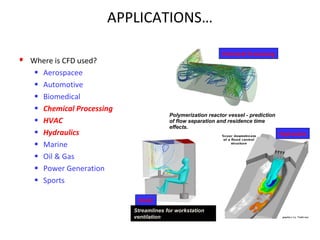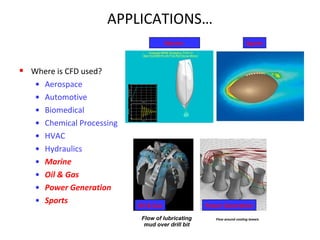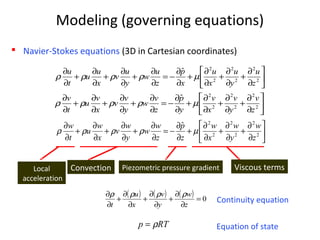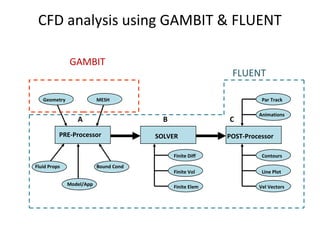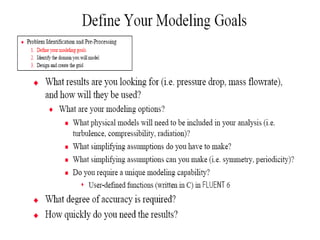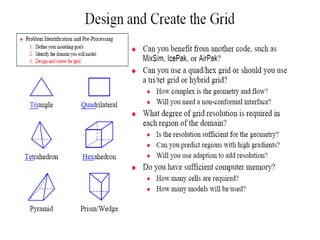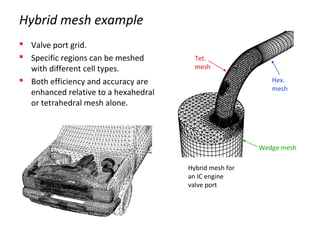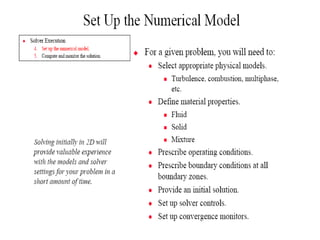FLUID MECHANICS - COMPUTATIONAL FLUID DYNAMICS (CFD)
- 1. SRES’s Sanjivani College of Engineering, KOPARGAON Content Beyond Syllabus (CBS) on COMPUTATIONAL FLUID DYNAMICS (CFD) & ITS APPLICATIONS Subject: FLUID MECHANICS Class: S.E. (Mech) FACULTY: PROF. Y. H. AHIRE
- 2. FLUID DYNAMICS Fluid dynamics is the science of fluid motion. Fluid flow is commonly studied in one of three ways: • Experimental fluid dynamics. • Theoretical fluid dynamics. • Numerically: computational fluid dynamics (CFD). CFD nicely and synergistically complements the other two approaches but will never replace either of the two.
- 3. WHAT IS CFD? Computational fluid dynamics (CFD) is the science of predicting fluid flow, heat transfer, mass transfer, chemical reactions, and related phenomena by solving the mathematical equations which govern these processes using a numerical process. The governing equations are based on conservation of mass, momentum, energy, chemical species etc. The result of CFD analyses is relevant engineering data used in: • Conceptual studies of new designs • Detailed product development • Troubleshooting • Redesign
- 4. WHY USE CFD? CFD is an alternative to experiments that are expensive, time-consuming, difficult, dangerous or impossible and also to theoretical methods which can tackle only simplied cases. CFD complements experiments and theory. CFD is used for design & development, for research and in education. The use of CFD has steadily increased in design; currently upto 40%.
- 5. APPLICATIONS OF CFD . Where is CFD used? • Aerospace • Automotive • Biomedical • Chemical Processing • HVAC • Hydraulics • Marine • Oil & Gas • Power Generation • Sports F18 Store Separation Temperature and natural convection currents in the eye following laser heating. Aerospace Automotive Biomedical
- 6. APPLICATIONS… . Polymerization reactor vessel - prediction of flow separation and residence time effects. Streamlines for workstation ventilation Where is CFD used? • Aerospacee • Automotive • Biomedical • Chemical Processing • HVAC • Hydraulics • Marine • Oil & Gas • Power Generation • Sports HVAC Chemical Processing Hydraulics
- 7. APPLICATIONS… . Where is CFD used? • Aerospace • Automotive • Biomedical • Chemical Processing • HVAC • Hydraulics • Marine • Oil & Gas • Power Generation • Sports Flow of lubricating mud over drill bit Flow around cooling towers Marine Oil & Gas Sports Power Generation
- 8. CFD - how it works ? Analysis begins with a mathematical model of a physical problem. Conservation of matter, momentum, and energy must be satisfied throughout the region of interest. Fluid properties are modeled empirically. Simplifying assumptions are made in order to make the problem tractable (e.g., steady-state, incompressible, inviscid, two-dimensional). Provide appropriate initial and boundary conditions for the problem. Domain for bottle filling problem. Filling Nozzle Bottle
- 9. CFD - how it works… CFD applies numerical methods (called discretization) to develop approximations of the governing equations of fluid mechanics in the fluid region of interest. • Governing differential equations: algebraic. • The collection of cells is called the grid. • The set of algebraic equations are solved numerically (on a computer) for the flow field variables at each node or cell. • System of equations are solved simultaneously to provide solution. The solution is post-processed to extract quantities of interest (e.g. lift, drag, torque, heat transfer, separation, pressure loss, etc.). Mesh for bottle filling problem.
- 10. Modeling (governing equations) Navier-Stokes equations (3D in Cartesian coordinates) ∂ ∂ + ∂ ∂ + ∂ ∂ + ∂ ∂ −= ∂ ∂ + ∂ ∂ + ∂ ∂ + ∂ ∂ 2 2 2 2 2 2 ˆ z u y u x u x p z u w y u v x u u t u µρρρρ ∂ ∂ + ∂ ∂ + ∂ ∂ + ∂ ∂ −= ∂ ∂ + ∂ ∂ + ∂ ∂ + ∂ ∂ 2 2 2 2 2 2 ˆ z v y v x v y p z v w y v v x v u t v µρρρρ ( ) ( ) ( ) 0= ∂ ∂ + ∂ ∂ + ∂ ∂ + ∂ ∂ z w y v x u t ρρρρ RTp ρ= Convection Piezometric pressure gradient Viscous termsLocal acceleration Continuity equation Equation of state ∂ ∂ + ∂ ∂ + ∂ ∂ + ∂ ∂ −= ∂ ∂ + ∂ ∂ + ∂ ∂ + ∂ ∂ 2 2 2 2 2 2 ˆ z w y w x w z p z w w y w v x w u t w µρρρρ
- 11. Types of CFD codes Commercial CFD code: FLUENT, Star-CD, PHOENICS, CFDRC, CFX/AEA, etc. Research CFD code: CFDSHIP-IOWA Public domain software: (PHI3D, HYDRO, and WinpipeD, etc.) Grid generation software: (e.g. Gridgen, Gambit, TGrid) Flow visualization software: (e.g. Tecplot, FieldView) CFDSHIPIOWA
- 12. How Does a CFD Code Work? Geometry MESH Fluid Props. Model/App. Bound Conds. PRE-Processor SOLVER Finite Diff. Finite Vol. Finite Elem. POST-Processor Contours Line Plot Vel. Vectors Par. Track Animations CBA A. Pre-Processor Geometry definition or computational domain Generate mesh / grid or subdivisions Definitions of fluid properties Definition of physical or chemical phenomena to be modeled Specifications of boundary and initial conditions
- 13. How Does a CFD Code Work… B. SOLVER This is the heart of the code Involves applications of the discretized equation to each of the CV Basically 3 Steps are Involved : - • Approximation of the unknown flow variables • Discretization – Substitution of approximation into governing flow equations and subsequent manipulations • Solution of Algebraic Equation For Each Node 3 Methodologies are used : Finite Difference, Finite Volume, Finite Element Most Commercial Code use FV e.g. FLUENT, CFX, PHOENICS
- 14. For example, for general fluids motion – the PDE is called the Navier Stokes equations
- 15. How Does a CFD Code Work … C. Post-Processor Tabular/Graphical Display of the Output Results E.g. Contours, Line Plot, Vector Plot, Surface Plot, Particle Track
- 16. CFD analysis using GAMBIT & FLUENT GAMBIT Geometry MESH Fluid Props Model/App Bound Cond PRE-Processor SOLVER Finite Diff Finite Vol Finite Elem POST-Processor Contours Line Plot Vel Vectors Par Track Animations CBA FLUENT
- 21. Tri/Tet vs. Quad/Hex meshes For simple geometries, quad/hex meshes can provide high-quality solutions with fewer cells than a comparable tri/tet mesh. For complex geometries, quad/hex meshes show no numerical advantage, and you can save meshing effort by using a tri/tet mesh.
- 22. Hybrid mesh example Valve port grid. Specific regions can be meshed with different cell types. Both efficiency and accuracy are enhanced relative to a hexahedral or tetrahedral mesh alone. Hybrid mesh for an IC engine valve port Tet. mesh Hex. mesh Wedge mesh
- 27. Tools to Examine the Results Graphical tools – Grid, contour, and vector plots – Pathlines and particle trajectory plots – XY plots – Animations Numerical reporting tools – Flux balances – Surface and volume integrals and averages – Forces and moments
- 28. Velocity vectors around a dinosaur
- 29. Velocity magnitude (0-6 m/s) on a dinosaur
- 31. ADVANTAGES OF CFD Relatively low cost – Using physical experiments and tests to get essential engineering data for design can be expensive. – CFD simulations are relatively inexpensive, and costs are likely to decrease as computers become more powerful. Speed – CFD simulations can be executed in a short period of time. – Quick turnaround means engineering data can be introduced early in the design process. Ability to simulate real conditions – Many flow and heat transfer processes can not be (easily) tested, e.g. hypersonic flow. – CFD provides the ability to theoretically simulate any physical condition.
- 32. ADVANTAGES... Ability to simulate ideal conditions – CFD allows great control over the physical process, and provides the ability to isolate specific phenomena for study. – Example: a heat transfer process can be idealized with adiabatic, constant heat flux, or constant temperature boundaries. Comprehensive information – Experiments only permit data to be extracted at a limited number of locations in the system (e.g. pressure and temperature probes, heat flux gauges, LDV, etc.). – CFD allows the analyst to examine a large number of locations in the region of interest, and yields a comprehensive set of flow parameters for examination.
- 33. LIMITATIONS OF CFD Physical models – CFD solutions rely upon physical models of real world processes (e.g. turbulence, compressibility, chemistry, multiphase flow, etc.). – The CFD solutions can only be as accurate as the physical models on which they are based. Numerical errors – Solving equations on a computer invariably introduces numerical errors. – Round-off error: due to finite word size available on the computer. Round-off errors will always exist (though they can be small in most cases). – Truncation error: due to approximations in the numerical models. Truncation errors will go to zero as the grid is refined. Mesh refinement is one way to deal with truncation error.
- 34. LIMITATIONS… Boundary conditions – As with physical models, the accuracy of the CFD solution is only as good as the initial/boundary conditions provided to the numerical model. – Example: flow in a duct with sudden expansion. If flow is supplied to domain by a pipe, you should use a fully-developed profile for velocity rather than assume uniform conditions. poor better Fully Developed Inlet Profile Computational Domain Computational Domain Uniform Inlet Profile
- 35. SUMMARY CFD is a method to numerically calculate heat transfer and fluid flow. Currently, its main application is as an engineering method, to provide data that is complementary to theoretical and experimental data. This is mainly the domain of commercially available codes and in-house codes at large companies. CFD can also be used for purely scientific studies, e.g. into the fundamentals of turbulence. This is more common in academic institutions and government research laboratories. Codes are usually developed to specifically study a certain problem.
- 36. REFERENCES J D Anderson, Computational Fluid Dynamics-Basics and Applications, TATA McGraw Hill. Fluent Inc.: Http://www.fluent.com Adapted from notes by: Tao Xing and Fred Stern, The University of Iowa.
- 37. Problems 1. CFD stands for: (a) Colourful Fluid Dynamics (b) Computational Fluid Dynamics (c) Computational Fluid Mechanics (d) Contour Fluid Dynamics. 2. Computations in CFD are done by (a) Human (b) Calculator (c) Computer (d) None. 3. CFD can be used in: (a) Automobile (b) Biomedical (c) Aerospace (d) All. 4. Navier-Stoke equation is manifestation of : (a) conservation of mass (b) conservation of momentum (c) conservation of energy (d) None of the above . 5. Navier-Stoke equation is : (a) ODE (b) PDE (c) Non-linear PDE (d) Non-linear ODE. 6. CFD can’t be applied to complicated geometries. (True/False).
- 38. Problems contd.. 7. Pre-processing involves: (a) Mathematical modeling (b) Analyzing data using contours (c) Solution of algebraic equations (d) None. 8. Post-processing involves : (a) Mathematical modeling (b) Analyzing data using contours (c) Solution of algebraic equations (d) None. 9. Turbulent modeling can be done using : (a) LES (b) RANS (c) DES (d) All. 10. Discretization methods are : (a) Finite difference method (FDM) (b) Finite volume method (FVM) (c) Finite element method (FEM) (d) All. 11. Videos/contours/plots can be made in CFD. True/False.





